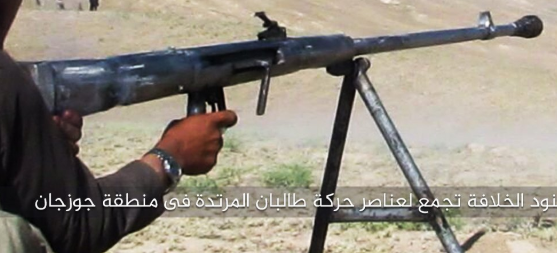In what would certainly make the gun makers of Darra Adam Khel blush with professional embarrassment, a recent so-called Islamic State of Khurasan (IS entity in eastern Afghanistan) propaganda video showed fighters of the group engaging enemy Taliban fighters with a craft produced anti-materiel rifle. The rifle is extremely rudimentary, reminiscent of similarly constructed craft-produced rifles coming out of Iraq and Syria from workshops around the region.
Some Islamic State sniper action against Taliban forces in Wilayat Khurasan (Afghanistan). pic.twitter.com/mLYAL6xekR
— Oryx (@oryxspioenkop) July 10, 2018
The rifle is a manually repeating single shot design in construction, most likely chambered in 12.7x108mm or larger (14.5x114mm, or 20mm due to the widespread existence of Soviet Bloc surplus in the region), using a crudely turned over bolt handle that drives a hand placed round into the chamber where it rests in the circular receiver. The handle appears to have a short throw distance and appears to use a single lug, visible directly behind it, engaging in a cutout notch at the 3 o’clock position. Although not much of a buttpad, there is a slab of steel that is able to be disassembled for construction and cleaning. There is no front sight and the rear sight is stripped from another design. Bipods are two pipes (most likely hollow), that can pivot on a pin positioned at the front of the receiver.
What we are looking at is a what appears to be industrial steel components designed to fit around what might be a rifled barrel that was stripped from a different design. This was the basic principle behind many of the anti-materiel rifles in Iraq and Syria, especially with the Kurds and the Zagros. Why create a costly part when one can be pulled from a non-working one that fits the bill? With this in mind, one barrel profile that does look similar and is relatively plentiful in the region is the 12.7x108mm NSV. The contour of the muzzle brake and the distance of the front sight post support this conjecture.
But upon a closer examination, it may look similar from afar, but there are far too many differences between the barrels to even be a close fit. The front sight post is too high to be from the NSV and the barrel itself appears to be missing some of the specific marks from attaching the gas system to it. Another important note here is that the barrel itself looks unfinished or at least not treated after construction. So it couldn’t have come from a manufactured barrel in the first place.
 Your Privacy Choices
Your Privacy Choices



